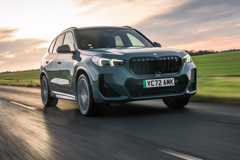Smart #5 Review 2025
Smart #5 At A Glance
These are critical times for the Smart brand. Originally famed for its Mercedes-engineered Smart Fortwo city cars, sales declined to such a degree that the marque was reimagined for the EV age with new co-owners Geely. Unfortunately, its first two new-era models, both electric SUVs, are hardly setting the monthly registration charts alight, meaning expectations that its latest offering — the Smart #5 — can turn things around are more amplified than they might otherwise be.
Its predicament is interesting, especially as the smallest Smart #1 shares its underpinnings and electrical drive systems with the Volvo EX30, a compact SUV which suddenly feels omnipresent across the UK’s highways. That sales imbalance has hardly been redressed since the release of the slinkier Smart #3, hence hopes are extraordinarily high for the #5.
As is hinted at by its higher numeral, the Smart #5 is much lengthier than its hashtaggy siblings. In fact, at 4695mm from bumper-to-bumper, the #5 is quite a bit longer than many other five-seater electric SUVs that are selling strongly. For reference this giant Smart dwarfs the excellent Renault Scenic E-Tech. Blimey.
Although they also overlap the expected starting price in the region of £40,000, Smart has aspirations for the #5 beyond such mainstream choices judging by its wealth of on-board technology. Compared with the likes of the Audi Q4 e-tron and the BMW iX1, the Smart should seem like a value-for-money-centric proposition, not least considering how much extra bodywork your money buys you.
While the pricing could prove too rich for many private buyers the #5’s company car tax Benefit-in-Kind (BiK) banding of just 3% means it could potentially garner a strong following among user-choosers.
Talking of which, while the #5 shares the smaller Smarts’ strong-shouldered and smooth bodysides, anyone would have a hard time convincingly arguing that its nose and tail styling promote a unified family look. With four supplementary LED pods linking the main lighting units at the front and rear, the #5 feels somewhat overwrought but it is at least distinctive and has some of that intangible quality that injects a little personality.
Interior touches look like they owe more to familiar Mercedes fixtures and fittings, including the centre console armrest that splits along the middle when opened to reveal a storage cubby below, with a pair of cupholders and two smartphone charging pads ahead of it. The 256-coloured LED ambient lighting system also has a Merc vibe to it.
Forming the main dashboard area are what appear to be two rectangles with semi-circular ends. The larger of these contains the 10.25-inch driver’s display screen containing electronic dials, while the smaller one stretches from the centre right across to the passenger side. On the cheapest two #5s this contains a 13.0-inch multimedia OLED touchscreen but pricier models have another of the same size for the front seat passenger to use.
More expensive Smart #5s also supplement the driver’s screen with a 25.6-inch — yes, you read that correctly — head-up display projection on the inside of the windscreen that incorporates augmented reality navigation instructions.
Despite all of the technology it carries, Smart hasn’t forgotten that the #5 also needs to comfortable accommodate its passengers and their caboodle. With the rear seat in use boot space is quoted at a very generous 630 litres, although when folded the 1530-litre maximum capacity is useful rather than extraordinary. Pop the bonnet to find a frunk with a 72-litre capacity in rear-wheel drive models, reduced to 47 litres in all-wheel drive versions which have a second motor powering the front wheels.
The Smart #5’s rear seats split-fold in a 60/40 configuration and lie almost flat when tumbled. Extra flexibility’s provided by a ski hatch for lengthy-but-slender items that’s revealed when the rear centre armrest’s lowered, plus the front seats can be reclined almost horizontally to provide a makeshift two-berth camping area.
When the Smart #5 range is launched in the UK it will consist of six models which together represent four different drive systems with eye-widening statistics across the line-up:
- Pro — rear-wheel drive, 340PS, 373Nm of torque, 6.9-second 0-62mph, 74.4kWh battery, provisional WLTP Combined cycle driving range of 288 miles
- Pro+ and Premium — rear-wheel drive, 363PS, 373Nm of torque, 6.5-second 0-62mph, 94kWh battery, provisional WLTP Combined cycle driving range of 366 miles
- Pulse and Summit Edition — all-wheel drive, 587PS, 643Nm of torque, 4.9-second 0-62mph, 94kWh battery, provisional WLTP Combined cycle driving range of 335 miles
- Brabus — all-wheel drive, 646PS, 710Nm of torque, 3.8-second 0-62mph, 94kWh battery, provisional WLTP Combined cycle driving range of 335 miles
Top speed for all Smart #5s is electronically capped at 124mph except for the Brabus which is extended to 130mph.
There’s a different chemical makeup to the 74.4kWh battery which makes it cheaper to produce but also restricts its charging speed potential compared with the 94kWh pack fitted to most models in the range. The smaller unit employs lithium iron phosphate technology while the larger one is able to store energy more densely due to its use of lithium nickel manganese cobalt oxides.
What the means in reality is that the 74.4kWh battery has a maximum AC charging rate of 11kW meaning a 10-100% replenishment requires up to 8 hours 30 minutes, while the 94kWh version can handle 22kW of AC energy flow completing the same recharge in 5 hours 30 minutes.
Those differences are even more stark when it comes to using DC ultra-rapid public chargers — a 10-80% top-up of the smaller battery is limited because of its maximum energy flow rate of 150kW, taking up to 30 minutes. As the larger one can manage a 400kW energy flow it can be zapped to the same level in under 18 minutes. That’s assuming you can find a 400kW charger delivering the goods, of course.
Exact specification levels and prices for the Smart #5 are expected to be revealed in the third quarter of 2025 when order books open. Customer deliveries should commence before the end of the year. Smart will be hoping you notice significant numbers of them very soon afterwards.
Keep this page bookmarked for further news on this important new range and to read our forthcoming full and comprehensive Smart #5 review in the weeks ahead.









 Extraordinary performance and range figures. Tech-fest interior remains spacious and flexible. Distinctive styling, if not particularly Smart-like.
Extraordinary performance and range figures. Tech-fest interior remains spacious and flexible. Distinctive styling, if not particularly Smart-like.
 Pricing will restrict appeal among private buyers. Is it so far removed from the brand’s origins for it to make sense being badged as a Smart?
Pricing will restrict appeal among private buyers. Is it so far removed from the brand’s origins for it to make sense being badged as a Smart?




